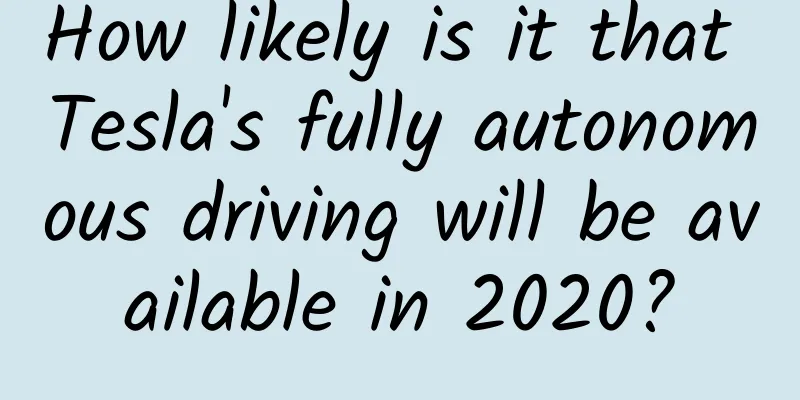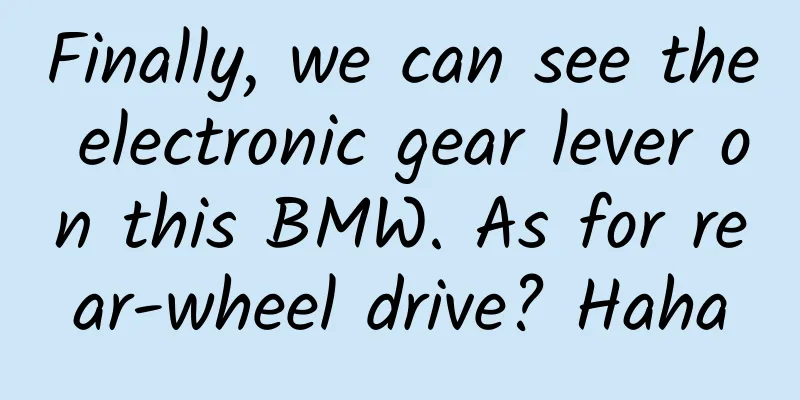How likely is it that Tesla's fully autonomous driving will be available in 2020?

|
With the mass production of the Shanghai Super Factory, it is no longer a distant dream for more Chinese people to buy and own a Tesla. Speaking of Tesla, in addition to the new driving experience brought by electric vehicles, the automatic assisted driving function brought by the Autopilot function has also become a major feature. It is precisely the modern functions such as automatic parking and summoning that give Tesla a differentiated advantage in competing with luxury cars such as Mercedes-Benz and BMW in the electric vehicle field. As of now, Tesla's market value has exceeded 100 billion US dollars, making it the world's second largest automaker by market value after Toyota. Compared with the widely expected positive effect of a significant increase in delivery volume, if Tesla's autonomous driving can be implemented faster in 2020, it will definitely bring more surprises to investors. Compared with Musk's Mars immigration plan, when will the "full autonomous driving technology" he claims be implemented? Obviously, this is also a question that Tesla owners are more concerned about. 1. Tesla's fully autonomous driving is getting closer As early as the end of 2018, Musk announced that his "fully autonomous driving technology" would be realized in 2019. The public did not believe this very much, and Iron Man broke his promise again as expected. In June 2019, Musk changed his words at Tesla's annual shareholders meeting and said that Tesla users will be able to use the autonomous driving function without human intervention sometime in 2020. All models produced after October 2016 only need to replace the autonomous driving chip to achieve full autonomous driving function. The chip Musk mentioned is the "full self-driving computer" (FSD) launched by Tesla in April 2019. It is also Tesla's third-generation main processor chip, with 6 billion transistors, capable of completing 144 trillion calculations per second, and processing 2,300 frames per second. Compared with Tesla's previous generation processor (HW2.5), FSD has improved its performance by 21 times and can handle the amount of perception layer data and computing power required for L5-level autonomous driving. Since the official launch of FSD, Tesla's self-developed chip, Tesla has equipped its Model X, Model S, and Model 3 cars with it, and has also upgraded its previous models. On January 16, 2020, Tesla's official Weibo account stated that more than 600,000 of its cars are currently equipped with fully autonomous driving chips. On Christmas Eve 2019, Tesla launched the FSD sneak preview. Based on user feedback, Tesla enhanced the "driving visualization" function in this version, which can recognize traffic lights and colors, road lines/parking signs, trash cans, pile barrels, etc. Professionals analyzed that in the preview version of Tesla's update, the visualization of stop signs and parking lights cannot replace the driver and will not stop the car. In other words, it will take some time for Tesla to truly realize the key issue of planning and control at traffic light intersections. It is undeniable that Tesla has also developed an autonomous driving assistance system that has been commercialized on a large scale and has made the fastest progress and provided the best experience to date. In the field of driverless driving with a trillion-dollar market space, Tesla is still an important force that cannot be ignored. From a certain perspective, Tesla's intelligent advantages seem to attract more people's interest than electrification itself. Unlike mainstream manufacturers, Tesla did not wait until everything was complete before launching its autonomous driving technology, but chose to gradually open up related functions. On the one hand, this allows the public to have the fun of participating earlier. On the other hand, Tesla has also obtained valuable massive driving data through the massive delivery of vehicles, and then improved and upgraded its autonomous driving functions. Although this has also brought some safety accidents and doubts, on the whole, the advantage seems to have returned to Tesla. 2. Tesla’s autonomous driving development history 1. Autopilot Hardware 1.0 According to information, Tesla first started planning Autopilot in 2013. In the early stages of the Autopilot project, Tesla and Google discussed cooperation limited to autonomous driving on highways. However, due to Google's concerns about the safety of semi-autonomous driving, Google eventually decided to give up and instead focus on L4-L5 autonomous driving solutions. Tesla chose to join hands with Mobileye and developed the first generation of Autopilot in October 2014. The so-called Autopilot refers to a set of autonomous driving applications that includes hardware and software, which is equivalent to the combination of iPhone and IOS system. After the release of Autopilot 1.0, smart driving became an important selling point to boost Tesla's sales. By 2016, Tesla had sold about 100,000 Model S and Model X equipped with Autopilot Hardware 1.0. However, an accident in 2016 brought a storm to the then-hot Tesla. In May 2016, a car owner named Joshua Brown was driving a Model S and crashed into a turning truck on a section of Florida highway that was not completely closed. The black Model S went out from the bottom of the car, and the owner Joshua Brown died in the car accident. Subsequent investigations showed that Autopilot did not recognize the white trailer of the truck, so it did not brake in time, which eventually led to the collision between the Model S and the truck trailer. Although this scene is relatively rare, as the first fatal accident caused by autonomous driving in the world, it still attracted widespread media coverage and had a significant impact on the entire automotive industry. At the same time, there have been subtle changes in the cooperation between Tesla and Mobileye. In Mobileye's view, the accident itself is not a technical problem, but the fact that the autopilot function that Tesla has opened to car owners is too advanced. Tesla also believes that Mobileye's enthusiasm and progress in improving the Autopilot function are difficult to satisfy, and from a long-term perspective, it is not a long-term solution for the core technology of autopilot to be controlled by others. 2. Autopilot 2.0 In July 2016, Tesla and Mobileye officially terminated their cooperation. At this time, Tesla had invited AMD's chip master Jim Keller. As the vice president of Autopilot hardware engineering, Keller led the team to launch the second-generation autonomous driving hardware system Autopilot 2.0 equipped with NVIDIA chips. In October 2016, models equipped with Autopilot 2.0 began mass production, and Musk claimed at the time that the hardware solution of Autopilot 2.0 could achieve fully autonomous driving. Although this statement has been widely questioned, it is a fact that Teslas equipped with this system already have the ability to drive autonomously on open roads. As of July 2019, more than 500,000 Tesla cars around the world are equipped with the Autopilot Hardware 2.0 system. According to the data, Tesla's Autopilot 2.0 version includes 8 cameras, 1 millimeter-wave radar, 12 ultrasonic radars, and is equipped with a custom-made NVIDIA DRIVE PX2 AutoCruise computing motherboard. Compared with the previous 1.0 version which only had 1 camera, Autopilot has greatly improved the system's perception capabilities through hardware enhancements, and can cover a range of 250 meters around the vehicle. NVIDIA DRIVE PX2 was also the top chip in the field of autonomous driving at the time, with a computing power 40 times higher than the previous generation, which can already support the needs of unmanned driving. However, considering the power consumption requirements of autonomous driving and Tesla's persistent pursuit of commercialization and mass production of autonomous driving, while Keller was developing the hardware system Autopilot 2.0, he was also developing a new generation of chips (FSD), which is the Autopilot 3.0 version. 3. Autopilot 3.0 In fact, from the day Autopilot 2.0 was released, Tesla seemed to have kept a trick up its sleeve, because the hardware of version 2.0 supports chip replacement for better computing power. From another perspective, chips are the core technology of autonomous driving, and Tesla is clearly unwilling to be controlled by others in this field. As a company with a grand blueprint in the field of autonomous driving, having independent chip design and production capabilities can not only complete the most important closed loop in the industrial chain, but also reduce costs by increasing future capacity. In March 2019, Tesla's self-developed main processor chip FSD was officially launched, and Tesla officially entered the Autopilot 3.0 system era. Compared with Nvidia chips, FSD has a performance limit of 200 frames per second when processing videos provided by cameras. FSD has achieved a processing performance of 2,300 frames per second, while power consumption is only 25% higher than the previous generation of chips, and a dual-chip design has reserved some capacity as redundancy for vehicle safety. The release of FSD means that Tesla has full control over computing. From the comprehensive performance of HW3.0, it is fully capable of handling the amount of perception layer data and computing power required for L5-level autonomous driving, becoming a core competitiveness of Tesla in the field of autonomous driving. III. Opportunities and Challenges According to the SAE Association (Society of Automotive Engineers) standards, autonomous driving technology is divided into six levels, L0-L5, of which L0-L2 is assisted driving, L3 and above are high-level autonomous driving, and only when it reaches L4 can it truly achieve unmanned driving, but there are still restrictions on scenarios. In a broad sense, when the standards of autonomous driving cars reach L3 and above, it can be called true autonomous driving, that is, "unmanned driving." One scenario that can be imagined is that once people are completely freed from driving, the product functions of cars will be redefined. At this time, people can do many activities such as office work and entertainment in the car, and the internal structure of the car will be very different from the current one. In this way, cars will become "mobile commercial real estate" and will generate many business opportunities. Relevant research institutions predict that the market space brought by driverless cars will be trillions or even tens of trillions, even larger than the market space of electric vehicles itself. This once-in-a-lifetime opportunity has attracted a large number of domestic and foreign companies to join in. Among them, they can be divided into two camps: Internet giants and traditional car companies. The first category is Internet companies represented by Google and Baidu. These companies have advantages in capital, talent and system software, but due to the lack of accumulation in automotive hardware and supply chain management, Internet companies are more willing to build an unmanned driving platform. At present, both Waymo in the United States and Baidu Apollo in China are in the leading position in their respective domestic industries. The second category is traditional car companies. Compared with Internet giants, car companies are not superior in terms of capital and talent. However, facing the trillion-level intelligent trend, traditional car companies have bid farewell to their previous single-handed struggle and began to focus on working together. In the era of fuel vehicles, rivals who were irreconcilable suddenly became close partners in the field of autonomous driving. Whether it is the cooperation between Volkswagen and Ford, or the establishment of the autonomous driving alliance between Daimler and BMW, it declares that traditional car companies are beginning to become pragmatic and united. Tesla, which is neither an Internet company nor a traditional car company, has become a force that cannot be ignored in the field of autonomous driving through its persistent belief in autonomous driving and R&D investment. Some people even believe that Tesla is about to become the iPhone of the automotive industry. Through the closed-loop construction of both software and hardware, Tesla's advantage in software and hardware integration in the automotive field is very close to Apple's advantage in the mobile phone field from chips to systems and hardware design systems. However, despite being called "full autonomous driving" by Musk, the Autopilot function itself is still an assisted driving technology. If we start from the internationally accepted SAE Association standards of the United States, Tesla's Autopilot autonomous driving is still between L2 and L3, and still requires the participation of the driver, and is not truly "unmanned driving." At the same time, the lack of laws and regulations also makes it difficult for driverless cars to be implemented. Even Tesla has announced that it will "gradually open up capabilities equivalent to Level 4 autonomous driving." In this way, if an accident occurs, the driver is still the responsible party. So far, L3 and above self-driving cars have not been mass-produced, but assisted driving functions have been adopted by many manufacturers and have become an important gimmick in the promotion of new cars. From the perspective of technical difficulty and functional realization, there is not much essential difference between Tesla and other cars. However, due to early market education and Musk's tireless pursuit of technological realization, Tesla and its AutoPilot are still the most talked-about topics in the field of autonomous driving. Since the third quarter of 2019, Tesla's stock price has soared by more than 130%, stimulated by the continuous launch of new products and the breaking of production capacity bottlenecks. The market has also successfully exceeded US$100 billion, becoming the world's second largest automaker by market value after Toyota. Compared with the widely expected positive of a significant increase in delivery volume, if Tesla's autonomous driving can be truly implemented in 2020, it will surely bring more surprises to investors. Compared with the indefinite testing of traditional automakers in the field of autonomous driving, Tesla, which continues to open up functions, has given users a gradual sense of participation and experience, which is also an important reason why Tesla can sell well around the world. As a winner of Toutiao's Qingyun Plan and Baijiahao's Bai+ Plan, the 2019 Baidu Digital Author of the Year, the Baijiahao's Most Popular Author in the Technology Field, the 2019 Sogou Technology and Culture Author, and the 2021 Baijiahao Quarterly Influential Creator, he has won many awards, including the 2013 Sohu Best Industry Media Person, the 2015 China New Media Entrepreneurship Competition Beijing Third Place, the 2015 Guangmang Experience Award, the 2015 China New Media Entrepreneurship Competition Finals Third Place, and the 2018 Baidu Dynamic Annual Powerful Celebrity. |
<<: Musk announced plans to build factories on all continents to meet market demand
Recommend
In addition to red envelopes, the Spring Festival Gala also has black technology
What? You’ve finished watching the Spring Festiva...
Some are happy, some are worried. The reason why the radio and television industry is making another move may be because TVOS2.0 is coming.
Recently, a ban issued by the State Administratio...
The iPhone is not immune: The smartphone industry has officially become “PC-ized”
2018 is coming to an end. A lot of things happene...
4 essential elements of an event operation plan!
A complete activity plan should have the followin...
From 0 to 1, the entire private domain traffic operation and promotion plan!
Every time I attend an offline get out of class, ...
After watching ofo’s new ad, I threw away the client’s brief!
Recently, ofo, the shared yellow bike company, re...
The truth behind the inability to mute camera calls on Japanese cell phones: It’s not to prevent sneak shots
In Japan, mobile phone camera does not provide a ...
4 cases to teach you how to use TikTok to promote products!
With the disappearance of the Internet traffic di...
Alipay is in big trouble! Huabei and Jiebei will be disconnected, and Yu'ebao will also be affected
[[396720]] Since Ant Group's IPO was suspende...
Server Hosting Transfer Notes
Server Hosting Transfer Notes 1. Debug website pr...
Winning the championship for 43 consecutive months and occupying half of the industry, Haier's 80 billion+ big data creates smart homes
In the future, every family will become a "r...
These Chinese scientists have built a photonic city on a chip the size of a little fingernail!
Produced by: Science Popularization China Author:...
What key points should be paid attention to when operating WeChat mini programs?
Currently, the popularity of WeChat mini-programs...
I sent out 60,000 red envelopes, and what did I get?
1 I checked the red envelope records today and fo...
Xingping SEO Training: What are the techniques for quickly indexing web pages in Baidu?
Internet search engine optimization has been soug...









